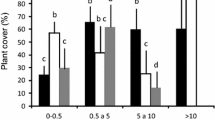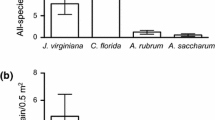Abstract
Quantification of seed rain patterns is an initial step toward explaining variation in plant recruitment, and consequently, organization of forest communities. Spatially contagious patterns of seed deposition, where seeds are patchily dispersed with some sites receiving relatively high densities and others receiving low densities of seeds, may be a common phenomenon for which we have very little knowledge. For example, prior feeding events by frugivores (monkeys and birds) combined with transport and dispersal of seeds to other fruiting trees may result in the contagious deposition of non-conspecific seeds below them. Here, we examined whether fruiting trees act as dispersal foci in the semi-deciduous tropical rainforest of the Dja Reserve, Cameroon. Seed rain was sampled below the canopies of nine tree species: three typically dispersed by large, frugivorous birds, three dispersed by monkeys, and three dispersed by wind. We found no evidence that monkeys generate spatially contagious patterns of seed rain under fruiting trees at which they feed. However, we found that rates of deposition of non-conspecific seeds and species richness of seeds delivered by birds (hornbills and turacos) were significantly greater during fruiting than non-fruiting periods, and significantly greater under fruiting individuals of bird-dispersed tree species than under fruiting individuals of monkey- or wind-dispersed tree species. Additionally, during fruiting periods, the composition of non-conspecific seed rain under bird-dispersed tree species was more similar to other bird-dispersed trees than to monkey- or wind-dispersed tree species. The contagious dispersal of non-conspecific seeds to fruiting, bird-dispersed trees leads to higher seed densities under fruiting trees than those caused by local seed production. Non-conspecific seeds deposited in high densities may experience increased seed mortality even far from parent trees if predators are generalists. Alternatively, in the absence of complete density-dependent mortality, contagious seed dispersal could result in associations among species dispersed by the same dispersal agent.


Similar content being viewed by others
References
Augspurger CK (1984) Seedling survival of tropical tree species: interactions of dispersal distance, light gaps and pathogens. Ecology 65:1705–1712
Augspurger CK, Kelly CK (1984) Pathogen mortality of tropical tree seedlings: experimental studies of the effects of dispersal distance, seedling density, and light conditions. Oecologia 61:211–217
Augspurger CK, Kitajima K (1992) Experimental studies of seedling recruitment from contrasting seed distributions. Ecology 73:1270–1284
Blake JG, Loiselle BA (1992) Fruits in the diets of Neotropical migrant birds in Costa Rica. Biotropica 24:200–210
Chapman CA, Wrangham RW, Chapman LJ, Kinnard DK, Zanne AE (1999) Fruit and flower phenology of two sites in Kibale National Park, Uganda. J Trop Ecol 15:189–211
Charles-Dominique P (1986) Inter-relations between frugivorous vertebrates and pioneer plants: Cecropia, birds and bats in French Guyana. In: Estrada A, Fleming TH (eds) Frugivores and seed dispersal. Junk, Dordrecht, The Netherlands, pp 119–135
Clark CJ (2001) Frugivore influence on patterns of seed rain, seed shadows and forest structure. Thesis. San Francisco State University, San Francisco, Calif., USA
Clark CJ, Poulsen JR, Parker VT (2001) The role of arboreal seed dispersal groups on the seed rain of a lowland tropical forest. Biotropica 33:606–620
Clark DA, Clark DB (1984) Spacing dynamics of a tropical rain forest tree: evaluation of the Janzen-Connell model. Am Nat 124:769–788
Condit R, Hubbell SP, Foster FB (1992) Recruitment near conspecific adults and the maintenance of tree and shrub diversity in a neotropical forest. Am Nat 140:261–286
Duncan RS, Chapman CA (1999) Seed dispersal and potential forest succession in abandoned agriculture in tropical Africa. Ecol Appl 9:998–1008
Forget P-M (1993) Post-dispersal predation and scatterhoarding of Dipteryx panamensis (Papilionaceae) seeds by rodents in Panama. Oecologia 94:255–261
Forget P-M, Sabatier D (1997) Dynamics of the seedling shadow of a frugivore-dispersed tree species in French Guiana. J Trop Ecol 13:767–773
Fragoso JMV (1997) Tapir-generated seed shadows: scale-dependent patchiness in the Amazon rain forest. J Ecol 85:519–529
Fragoso JMV, Huffman JM (2000) Seed-dispersal and seedling recruitment patterns by the last Neotropical megafaunal element in Amazonia, the tapir. J Trop Ecol 16:369–385
Gauch HG (1982) Multivariate analysis in community ecology. Cambridge University Press, Cambridge, UK
Godoy JA, Jordano P (2001) Seed dispersal by animals: exact identification of source trees with endocarp DNA microsatellites. Mol Ecol 10:2275–2283
Guimaraes Vieira IC, Uhl C, Nepstad D (1994) The role of the shrub Cordia multispicata Cham. as a ‘succession facilitator’ in an abandoned pasture, Paragominas, Amazonia. Vegetatio 115:91–99
Hardesty BD, Parker VT (2003) Seed rain of a central African tropical forest. Plant Ecol 164:49–64
Herrera CM (1984) A study of avian frugivores, bird-dispersed plants, and their interaction in Mediterranean scrublands. Ecol Monogr 54:1−23
Holbrook K, Smith TB (2000) Seed dispersal and movement patterns in two species of Ceratogymna hornbills in a West African tropical lowland forest. Oecologia 125:249–257
Howe HF (1989) Scatter- and clump-dispersal and seedling demography: hypothesis and implications. Oecologia 79:417–426
Howe HF, Smallwood J (1982) Ecology of seed dispersal. Annu Rev Ecol Syst 13:201–228
Hutchinson HM, Dalziel D, Hepper FN (1963) Flora of West Tropical Africa, 2nd edn. Crown Agents, Millbank, London
Janzen DH (1970) Herbivores and the number of tree species in tropical forests. Am Nat 104:501–528
Janzen DH (1986) Mice, big mammals, and seeds: it matters who defecates what where. In: Estrada A, Fleming TH (eds) Frugivores and seed dispersal. Junk, Dordrecht, The Netherlands, pp 251–271
Janzen DH, Miller GA, Hackforth-Jones J, Pond CM, Hooper K, Janos DP (1976) Two Costa Rican bat-generated seed shadows of Andira inermis (Leguminoseae). Ecology 57:1068–1075
Jongman RHG, ter Braak CJF, van Tongeren OFR (1995) Data analysis in community and landscape ecology. Cambridge University Press, Cambridge
Jordano P (1992) Fruits and frugivory. In: Fenner M (ed) Seeds: the ecology of regeneration in plant communities. Commonwealth Agricultural Bureau International, Wallingford, UK, pp 105–156
Jordano P (2000) Fruits and frugivory. In: Fenner M (ed) Seeds: the ecology and regeneration of plant communities. CAB International, Oxon, UK, pp 125–166
Julliot C (1997) Impact of seed dispersal of red howler monkeys Alouatta seniculus on the seedling population in the understory of tropical rain forest. J Ecol 85:431–440
Kruijger DL, Opdam M, Théry M, Bongers F (1997) Courtship behavior of manakins and seed bank composition in a French Guianan rain forest. J Trop Ecol 13:631–636
Laclavère G (1980) Atlas of the United Republic of Cameroon. Editions Jeune Afrique, Paris, France
Laman TG (1996) Ficus seed shadows in a Bornean rain forest. Oecologia 107:347–355
Lambert JE (1999) Seed handling in Chimpanzees ( Pan troglodytes) and Redtail monkeys ( Cercopithecus ascanius): implications for understanding Hominoid and Cercopithecine fruit-processing strategies and seed dispersal. Am J Phys Anthropol 109:365–386
Letouzey R (1970) Manuel de botanique forestière. CTFT, Nogent sur Marne, France
Loiselle BA (1990) Seeds in droppings of tropical fruit-eating birds—importance of considering seed composition. Oecologia 82:494–500
Loiselle B (1996) Spatial and temporal variation of seed rain in a tropical lowland wet forest. Biotropica 28:82–95
McDonnell MJ, Stiles EW (1983) The structural complexity of old field vegetation and the recruitment of bird-dispersed plant species. Oecologia 56:109–116
Nathan R, Muller-Landau HC (2000) Spatial patterns of seed dispersal, their determinants and consequences for recruitment. Trends Ecol Evol 15: 278–285
Olupot W, Chapman CA, Waser PM, Isabirye-Basuta G (1997) Mangabey ( Cercocebus albigena) ranging patterns in relation to fruit availability and the risk of parasite infection in Kibale National Park, Uganda. Am J Primatol 43:65–78
Poulsen JR, Clark CJ, Smith TB (2001) Seed dispersal by a diurnal primate community in the Dja Reserve, Cameroon. J Trop Ecol 17:787–808
Poulsen JR, Clark CJ, Connor EF, Smith TB (2002) Differential resource use by primates and hornbills: implications for seed dispersal. Ecology 83:228–240
Schupp EW, Fuentes M (1995) Spatial patterns of seed dispersal and the unification of plant population ecology. Ecoscience 2:267–275
Schupp EW, Milleron T, Russo SE (2002) Dissemination limitation and the origin and maintenance of species rich tropical forests. In: Levey DJ, Silva WR, Galetti M (eds) Seed dispersal and frugivory: ecology, evolution and conservation. CABI, Wallingford, Oxfordshire, UK
Silva JMC, Uhl C, Murray G (1996) Plant succession, landscape management, and the ecology of frugivorous birds in abandoned Amazonian pastures. Conserv Biol 10:491–503
Sneath PHA, Sokal RR (1973) Numerical taxonomy. Freeman, San Francisco
Tailfer Y (1989) La forêt dense d’Afrique centrale. Identification pratique des principaux arbres. CTA, Paris
Tewksbury JJ, Nabhan GP, Norman D, Suzan H. Tuxill J, Donoman J (1999) In situ conservation of wild chilies and their biotic associates. Conserv Biol 13:98–107
Wenny DG (2000) Seed dispersal, seed predation, and seedling recruitment of a neotropical montane tree. Ecol Monogr 70:331–351
Wenny DG, Levey DJ (1998) Directed seed dispersal by bellbirds in a tropical cloud forest. Proc Natl Acad Sci USA 95:6204–6207
Whitney KD, Fogiel MF, Lamperti AM, Holbrook KM, Stauffer DJ, Hardesty BD, Parker VT, Smith TB (1998) Seed dispersal by Ceratogymna hornbills in the Dja Reserve, Cameroon. J Trop Ecol 14:351–371
Acknowledgements
We are grateful to the Ministry of Environment and Forests, Republic of Cameroon, for permission to work in the Dja Reserve. Financial and logistical support were provided by ECOFAC Cameroon, the NYZS/Wildlife Conservation Society, the EPA STAR Fellowship #U-915665–01–0, the Center for Tropical Research at San Francisco State University and the NIH Office of Research on Minority Health grant # 5 P20 RR11805. For dedicated field assistance we are indebted to D. Amiezeh, S. Hansen, S. Joe, P. Krushelnycky, K. Lucas, J. Mann, B. Martinez, C. Nishida, R. Sama, A. Scie, C. Stickler and S. Wahaj. Comments from K. Holder, D. Levey, W. Rendell, E. Schupp, H. Slabbekoorn, T. Smith, and two anonymous reviewers greatly improved this manuscript. We wish to acknowledge the additional support and contributions of B. Curran and J-P. Vautherin.
Author information
Authors and Affiliations
Corresponding author
Rights and permissions
About this article
Cite this article
Clark, C.J., Poulsen, J.R., Connor, E.F. et al. Fruiting trees as dispersal foci in a semi-deciduous tropical forest. Oecologia 139, 66–75 (2004). https://doi.org/10.1007/s00442-003-1483-1
Received:
Accepted:
Published:
Issue Date:
DOI: https://doi.org/10.1007/s00442-003-1483-1




